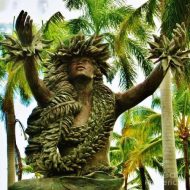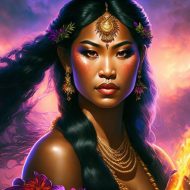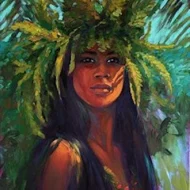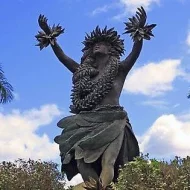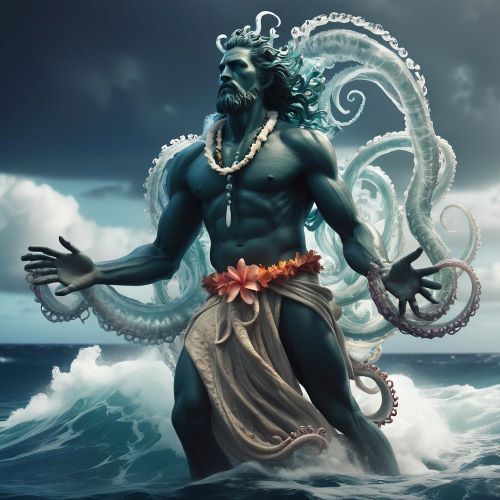Kapo : Goddess of Fertility
Listen
At a glance
| Description | |
|---|---|
| Origin | Hawaiian Mythology |
| Classification | Gods |
| Family Members | Pele (Sister) |
| Region | Hawaii |
| Associated With | Fertility, Sorcery |
Kapo
Introduction
In Hawaiian mythology, Kapo is a goddess or spirit known for her association with various aspects of life and death. She is often linked to fertility, childbirth, miscarriage, abortion, witchcraft, and prophecy. Kapo is considered a powerful and unpredictable figure, and she is both admired and feared in Hawaiian mythology.
One of Kapo’s notable attributes is her ability to reverse curses and malevolent spells, making her a figure of great significance in the spiritual and supernatural beliefs of ancient Hawaii. While she is associated with these aspects of life and death, Kapo is also known for her connection to hula, the traditional Hawaiian dance.
Physical Traits
Indeed, Kapo is sometimes referred to as Kapo-ʻula-kīnaʻu, and this epithet highlights a distinctive aspect of her appearance. Her attire is described as being red in color, adorned with black spots or markings. This distinctive attire adds to her unique character and presence in Hawaiian mythology.
Additionally, the story about Kapo having a detachable vagina is a well-known and intriguing aspect of her mythology. According to legend, she used this detachable body part as a decoy to aid her sister Pele in escaping from the advances of the overzealous and persistent Kamapuaʻa. This aspect of Kapo’s story reflects the creative and often unconventional nature of Hawaiian mythology, which is rich with symbolism and symbolism intertwined with the natural world and human experiences.
Family
Kapo’s familial connections and her role in Hawaiian mythology add depth to her character. According to tradition, Kapo’s mother is Haumea, the lunar spirit, while her younger sister and occasional traveling companion is the famous volcano spirit, Pele. Kapo’s story is intertwined with her arrival in Hawaii. She is believed to have been in Hawaii even before Pele arrived. In some accounts, Kapo is credited with founding hula schools on each of the Hawaiian islands upon her arrival, contributing to the preservation and spread of this sacred and cultural dance form across the archipelago. Her association with hula and her connection to the land and its spirits make Kapo a significant figure in Hawaiian mythology and cultural history.
Powers and Abilities
Kapo, a formidable and enigmatic presence in Hawaiian mythology. She holds sway over the domains of fertility, childbirth, miscarriage, abortion, and the inevitable realm of death. Kapo is a spirit entwined with the mystique of witchcraft and prophecy, renowned for her extraordinary ability to unravel even the most potent curses and malevolent spells. She commands admiration and respect, yet her power also evokes a deep-seated fear among those who encounter her.
Kapo’s significance extends to the realm of hula dancing, an art form deeply rooted in sacred rituals. While some legends credit her with the creation of hula, others hold Laka, the Hawaiian Spirit of Beauty, as the primary sacred matron of this mesmerizing dance. In the tapestry of Hawaiian mythology, Kapo stands as one of the preeminent spirits, adding layers of complexity and reverence to the ancient tradition of hula.
Modern Day Influence
Modern references to Kapo are not very common, but there are a few notable examples. One such reference can be found in the city of Kapolei, situated on the island of Oahu. The name “Kapolei” translates to “Beloved Kapo,” honoring the Hawaiian deity. Another reference to Kapo can be found in the name of Kohelepelepe, a volcanic crater also known as Koko Head, located on Oahu.
Additionally, the term “kapu” holds cultural and historical significance in Hawaii. “Kapu” is a Hawaiian word that means taboo or sacred. It was used to describe the ancient Hawaiian system of laws and rituals that governed various aspects of social and religious life. This kapu system, deeply ingrained in Hawaiian culture, was abolished in 1819 by King Kamehameha II, with the assistance of his mother Keōpūolani, who traced her lineage back to Kapo. The abolition of the kapu system marked a significant cultural and historical moment in Hawaii’s history.
Related Images
Frequently Asked Questions
What is lorem Ipsum?
I am text block. Click edit button to change this text. Lorem ipsum dolor sit amet, consectetur adipiscing elit. Ut elit tellus, luctus nec ullamcorper mattis, pulvinar dapibus leo.
What is lorem Ipsum?
I am text block. Click edit button to change this text. Lorem ipsum dolor sit amet, consectetur adipiscing elit. Ut elit tellus, luctus nec ullamcorper mattis, pulvinar dapibus leo.
What is lorem Ipsum?
I am text block. Click edit button to change this text. Lorem ipsum dolor sit amet, consectetur adipiscing elit. Ut elit tellus, luctus nec ullamcorper mattis, pulvinar dapibus leo.
What is lorem Ipsum?
I am text block. Click edit button to change this text. Lorem ipsum dolor sit amet, consectetur adipiscing elit. Ut elit tellus, luctus nec ullamcorper mattis, pulvinar dapibus leo.
What is lorem Ipsum?
I am text block. Click edit button to change this text. Lorem ipsum dolor sit amet, consectetur adipiscing elit. Ut elit tellus, luctus nec ullamcorper mattis, pulvinar dapibus leo.

